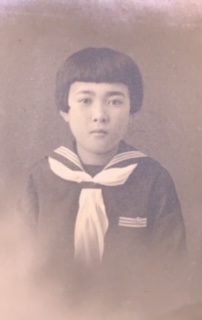Tokuso Hamai
Lost lives never come back
3. To the center of Hiroshima to search for my parents and sister

On the morning of the 8th, when I was leaving for school, Tsunayo, Sadako’s mother, said to me, “You should go to Hiroshima and look around for yourself.” Then, Hajime took me there, about 13km away, on the carrier of his bicycle. When we got to Koi, which is the western entrance of the city center, we found a vast stretch of black burned ruins. It seemed hard for us to go further by bicycle because debris was piled up in the roads, so we decided to leave the bicycle at a relative’s house in Koi and to go on foot. We walked to the east following the tracks of streetcars toward Nakajima-honmachi, where my house was located. On the way, in Fukushima-cho, which was just across the Yamate River from Koi, we saw railroad crossties still smoldering with small fires. Numerous dead bodies were lying along the tracks.
When we crossed the Tenma Railway Bridge, through the gaps of the railway crossties, I saw a pack of dead bodies floating below in the Tenma River, which were caught by the pillars of the bridge, almost damming the water of the river. Strangely, every dead body was swollen like a balloon. We kept walking to the east and got to the west end of the Honkawa Bridge. Nakajima-honmachi was on the other end of the bridge, but the bridge had collapsed. Seeing that we couldn’t cross the river there, we turned around, went back a little way and took a north turn. Then turning to the east and crossing the Aioi Bridge, we arrived in Nakajima-honmachi. This T-shaped bridge was the target for the bomber pilot to drop the A-bomb, because its shape was distinct enough to identify from high up in the sky.
My family house was in Nakajima-honmachi. In the area, houses were completely collapsed and totally burned black. Only piles of debris were left. Walking over the debris, we finally found the place where my family house had stood. I picked up a piece of wood about 10cm long and dug up the rubble with it. Then, I saw the familiar barber chairs of my father’s barber shop buried in the rubble about 70cm up from the shop’s tiled floor. That tiled floor was rare those days. On looking around, I recognized my father’s desk buried in the rubble, which was burned black. One of its drawers was open a little and there was a notebook in it. The four corners of the notebook wereburned off, becoming round. In Nakajima, we saw three living people for the first time after entering the city. Those people were also digging and turning up the rubble with pieces of wood. I thought they were also searching for their family members. It was totally quiet there. To my surprise, I could see Ninoshima Island, which I had never seen from there before.
Then, Hajime and I decided to go to Yasuda Girls’ High School, where my sister was a student. At that time Yasuda Girls’ High School was located on the north of Hiroshima Castle in Nishihakushima-cho. We crossed the Aioi Bridge again, took a right, went through the precinct of Gokoku Shrine and went around the castle to the school. On the way, the deep wide ditch around Hiroshima Teishin Hospital was filled with many swollen dead soldiers and horses.
When we arrived at the school, we saw a man standing there. I asked him for information about my sister, but he said that he didn’t know anything. So, we decided to go to the propeller factory where my sister should have been mobilized to work. On the way to the factory, we crossed the Kohei Bridge. At the foot of the bridge, we ate the lunch Tsunayo had made for us that morning. Lying beside us were three dead bodies in their military uniforms. They had no visible injuries but were all swollen large. By that time, I got insensitive to dead bodies because we had seen too many so far. The only other living people we saw there were some soldiers, dragging dead bodies to a temporary cremation spot.
In the end, we gave up searching for my parents and my sister and decided to return home. We walked westward to Yokogawa Station and followed the Japan National Railway tracks from there to Koi, where we had left our bicycle. Beside the tracks, several freight cars were overturned. Hajime and I were silent all the way, not saying any words. I don’t know where my sister died.
We returned to Miyauchi on the bicycle from Koi. When we got back, Tsunayo asked me, “What was the city like?” and I answered, “There wasn’t anything left.” Hearing me, she went to the closet and brought the dish clock, my father’s barber scissors and some bodily remains in her hands. She hadn’t shown the remains to me before, keeping them in the closet, because she thought I wouldn’t be convinced until I saw what my house was like with my own eyes. I had never cried before, but on seeing the remains and my family’s belongings, I burst into tears with a loud cry. Still, I believed deep in my heart that my parents could be all right and alive somewhere. When I heard Tsunayo mutter, “If I had expected something like this would happen, I should have received allowance money when they visited us on the 5th,” I felt bitter toward her. I still remember that bitterness.
I was left an orphan at the age of 11. My father died at 46, my mother at 35, my sister at 14 as a junior in Yasuda Girls’ High School, and my brother at 13 as a first-year student in Shudo Middle School.